Ecosystem Services for Planning: A Generic Recommendation or a Real Framework? Insights from a Literature Review
Abstract
1. Introduction
- the preparatory phase, i.e., the identification of the problems and opportunities that lead to specific planning issues and the establishment of planning goals;
- the investigation phase, i.e., the creation of an initial knowledge assessment of the context, collecting information on the physical, biological and social elements that constitute the planning area;
- the feasibility phase (the planning one), i.e., a first draft of the detailed studies aiming to understand the complex relationships between human values, environmental opportunities and constraints;
- the alternative scenarios phase, i.e., the development of different scenarios for the future management of the area, measuring and assessing their possible impacts;
- the formal planning phase, i.e., the drafting of land-use plans, zoning, building regulation plans;
- the implementation phase, i.e., the application of various strategies, tactics and procedures to reach the established goals;
- the operational phase, i.e., the monitoring and management strategies that aim to guarantee the effectiveness of the planning decisions.
2. Materials and Methods
- What purpose(s) are assigned to ESs in their role of supporting the planning process? [Q1]
- 2.
- Have ESs been integrated into the planning process? [Q2]
- If NO, it can be assumed that the integration of ESs into planning is merely a proposal, therefore, the purpose(s) assigned to ESs have already been investigated answering question 1;
- If YES, the following questions arise:
- 3.
- Is there a GI strategy based on ESs? [Q3]
- If YES: Has this been included in the planning process? What role(s) do GI have for planning purposes?
- If NO: Are there any proposals for the integration of GI into planning? What are they?
- 4.
- The type of planning, checking whether a single most prevalent planning type for the integration of ESs exists [Q4];
- 5.
- The categories of ESs, highlighting the presence of a specific category of ESs that may be more commonly considered than others for planning purposes [Q5];
- 6.
- ES mapping [Q6]. The addition of this aspect could serve to verify whether the current studies are still mostly focused on the spatial modelling of ESs or whether, in addition to these important assessments, an extra step has been taken by trying to integrate them into the planning process using the considerations derived from their mapping.
3. Results
3.1. Overview of the Purposes Assigned to ESs for Their Integration into Planning
- ESs for supporting the decision-making process
- 2.
- ESs as a new knowledge base
- 3.
- ESs as a means of better addressing planning aims
- 4.
- ESs for alternative scenario analysis
- 5.
- ESs for GI deployment
3.2. Planning Type, ESs Categories and ESs Mapping
- Planning type:
- 2.
- Categories of ESs:
- 3.
- ESs mapping:
3.3. ESs Integration in Planning: Some Best Practices from the Literature Review
4. Discussion
4.1. Main Outcomes of the Literature Review
4.2. Limitations of the Study
5. Conclusions
Funding
Institutional Review Board Statement
Informed Consent Statement
Data Availability Statement
Conflicts of Interest
References
- Cortinovis, C.; Geneletti, D. Ecosystem services in urban plans: What is there, and what is still needed for better decisions. Land Use Policy 2018, 70, 298–312. [Google Scholar] [CrossRef]
- Neugarten, R.A.; Langhammer, P.F.; Osipova, E.; Bagstad, K.J.; Bhagabati, N.; Butchart, S.H.M.; Dudley, N.; Elliott, V.; Gerber, L.R.; Gutierrez Arrellano, C.; et al. Tools for Measuring, Modelling, and Valuing Ecosystem Services: Guidance for Key Biodiversity Areas, Natural World Heritage sites, and Protected Areas; IUCN Library System: Gland, Switzerland, 2018. [Google Scholar]
- Tengö, M.; Hill, R.; Malmer, P.; Raymond, C.M.; Spierenburg, M.; Danielsen, F.; Elmqvist, T.; Folke, C. Weaving knowledge systems in IPBES, CBD and beyond—lessons learned for sustainability. Curr. Opin. Environ. Sustain. 2017, 26–27, 17–25. [Google Scholar] [CrossRef]
- UNEP-United Nations Environment Programme. Guidance Manual on Valuation and Accounting of Ecosystem Services for Small Island Developing States; UNON Publishing Service Section: Nairobi, Kenya, 2014; ISBN 9789280734072. [Google Scholar]
- Teixeira da Silva, R.; Fleskens, L.; van Delden, H.; van der Ploeg, M. Incorporating soil ecosystem services into urban planning: Status, challenges and opportunities. Landsc. Ecol. 2018, 33, 1087–1102. [Google Scholar] [CrossRef]
- Spyra, M.; Kleemann, J.; Cetin, N.I.; Vázquez Navarrete, C.J.; Albert, C.; Palacios-Agundez, I.; Ametzaga-Arregi, I.; La Rosa, D.; Rozas-Vásquez, D.; Adem Esmail, B.; et al. The ecosystem services concept: A new Esperanto to facilitate participatory planning processes? Landsc. Ecol. 2019, 34, 1715–1735. [Google Scholar] [CrossRef]
- Mascarenhas, A.; Ramos, T.B.; Haase, D.; Santos, R. Ecosystem services in spatial planning and strategic environmental assessment-A European and Portuguese profile. Land Use Policy 2015, 48, 158–169. [Google Scholar] [CrossRef]
- Ronchi, S. Ecosystem Services for Spatial Planning. Innovative Approaches and Challenges for Practical Applications; Green Ener.; Springer International Publishing AG: Cham, Switzerland, 2018; ISBN 9783319901848. [Google Scholar]
- De Groot, R.; Alkemade, R.; Braat, L.; Hein, L.; Willemen, L. Challenges in integrating the concept of ecosystem services and values in landscape planning, management and decision making. Ecol. Complex. 2010, 7, 260–272. [Google Scholar] [CrossRef]
- Galler, C.; Albert, C.; von Haaren, C. From regional environmental planning to implementation: Paths and challenges of integrating ecosystem services. Ecosyst. Serv. 2016, 18, 118–129. [Google Scholar] [CrossRef]
- Greiber, T.; Schiele, S. Governance of Ecosystem Services; IUCN: Gland, Switzerland, 2011; ISBN 978-2-8317-1427-1. [Google Scholar]
- Haines-Young, R.; Potschin-Young, M.; Czúcz, B. Report on the Use of CICES to Identify and Characterise the Biophysical, Social and Monetary Dimensions of ES Assessments. Available online: https://ec.europa.eu/research/participants/documents/downloadPublic?documentIds=080166e5abaa617f&appId=PPGMS (accessed on 9 June 2021).
- Andersson, E.; Barthel, S.; Borgström, S.; Colding, J.; Elmqvist, T.; Folke, C.; Gren, Å. Reconnecting Cities to the Biosphere: Stewardship of Green Infrastructure and Urban Ecosystem Services. Ambio 2014, 43, 445–453. [Google Scholar] [CrossRef]
- Gómez-Baggethun, E.; Gren, Å.; Barton, D.N.; Langemeyer, J.; McPhearson, T.; O’farrell, P.; Andersson, E.; Hamstead, Z.; Kremer, P. Urban ecosystem services. In Urbanization, Biodiversity and Ecosystem Services: Challenges and Opportunities: A Global Assessment; Springer: Amsterdam, The Netherlands, 2013; pp. 175–251. ISBN 9789400770881. [Google Scholar]
- Woodruff, S.C.; BenDor, T.K. Ecosystem services in urban planning: Comparative paradigms and guidelines for high quality plans. Landsc. Urban. Plan. 2016, 152, 90–100. [Google Scholar] [CrossRef]
- Tratalos, J.; Fuller, R.A.; Warren, P.H.; Davies, R.G.; Gaston, K.J. Urban form, biodiversity potential and ecosystem services. Landsc. Urban. Plan. 2007, 83, 308–317. [Google Scholar] [CrossRef]
- Alberti, M. The Effects of Urban Patterns on Ecosystem Function. Int. Reg. Sci. Rev. 2005, 28, 168–192. [Google Scholar] [CrossRef]
- Jansson, Å. Reaching for a sustainable, resilient urban future using the lens of ecosystem services. Ecol. Econ. 2013, 86, 285–291. [Google Scholar] [CrossRef]
- BenDor, T.K.; Spurlock, D.; Woodruff, S.C.; Olander, L. A research agenda for ecosystem services in American environmental and land use planning. Cities 2017, 60, 260–271. [Google Scholar] [CrossRef]
- Hölzingera, O.; Tringhamb, N.; Graysonb, N. Multiple Challenge Map for Birmingham: Ecosystem Services Supply and Demand Maps. Appendix 2 to Birmingham’s Green Living Spaces Plan 2013; Birmingham City Council: Birmingham, UK, 2013. [Google Scholar]
- Albert, C.; Aronson, J.; Fürst, C.; Opdam, P. Integrating ecosystem services in landscape planning: Requirements, approaches, and impacts. Landsc. Ecol. 2014, 29, 1277–1285. [Google Scholar] [CrossRef]
- Rall, E.L.; Kabisch, N.; Hansen, R. A comparative exploration of uptake and potential application of ecosystem services in urban planning. Ecosyst. Serv. 2015, 16, 230–242. [Google Scholar] [CrossRef]
- Mascarenhas, A.; Ramos, T.B.; Haase, D.; Santos, R. Integration of ecosystem services in spatial planning: A survey on regional planners’ views. Landsc. Ecol. 2014, 29, 1287–1300. [Google Scholar] [CrossRef]
- Peña, L.; de Manuel, B.F.; Méndez-Fernández, L.; Viota, M.; Ametzaga-Arregi, I.; Onaindia, M. Co-creation of knowledge for ecosystem services approach to spatial planning in the Basque Country. Sustainability 2020, 12, 5287. [Google Scholar] [CrossRef]
- Kabisch, N.; Qureshi, S.; Haase, D. Human-environment interactions in urban green spaces-A systematic review of contemporary issues and prospects for future research. Environ. Impact Assess. Rev. 2015, 50, 25–34. [Google Scholar] [CrossRef]
- Piwowarczyk, J.; Kronenberg, J.; Dereniowska, M.A. Marine ecosystem services in urban areas: Do the strategic documents of Polish coastal municipalities reflect their importance? Landsc. Urban. Plan. 2013, 109, 85–93. [Google Scholar] [CrossRef]
- Ronchi, S.; Arcidiacono, A.; Pogliani, L. Integrating green infrastructure into spatial planning regulations to improve the performance of urban ecosystems. Insights from an Italian case study. Sustain. Cities Soc. 2020, 53, 1–12. [Google Scholar] [CrossRef]
- Gómez-Baggethun, E.; Barton, D.N. Classifying and valuing ecosystem services for urban planning. Ecol. Econ. 2013, 86, 235–245. [Google Scholar] [CrossRef]
- Lennon, M.; Scott, M. Delivering ecosystems services via spatial planning: Reviewing the possibilities and implications of a green infrastructure approach. Town Plan. Rev. 2014, 85, 563–587. [Google Scholar] [CrossRef]
- Ronchi, S.; Arcidiacono, A. Lessons from Italian Experiences: Bottlenecks, New Challenges and Opportunities. In Ecosystem Services and Green Infrastructure. Perspective from Spatial Planning in Italy; Arcidiacono, A., Ronchi, S., Eds.; Springer International Publishing: Cham, Switzerland, 2021; pp. 225–236. ISBN 978-3-030-54345-7. [Google Scholar]
- European Commission. Building a Green Infrastructure for Europe; Publications Office of the European Union: Luxembourg, 2013. [Google Scholar]
- Rouse, D.C.; Bunster-Ossa, I.F. Green Infrastructure: A Landscape Approach; American Planning Association: Washington, DC, USA, 2013; ISBN 9781611900620. [Google Scholar]
- Matthews, T.; Lo, A.Y.; Byrne, J.A. Reconceptualizing green infrastructure for climate change adaptation: Barriers to adoption and drivers for uptake by spatial planners. Landsc. Urban. Plan. 2015, 138, 155–163. [Google Scholar] [CrossRef]
- Basnou, C.; Baró, F.; Langemeyer, J.; Castell, C.; Dalmases, C.; Pino, J. Advancing the green infrastructure approach in the Province of Barcelona: Integrating biodiversity, ecosystem functions and services into landscape planning. Urban. For. Urban. Green. 2020, 55. [Google Scholar] [CrossRef]
- Stefanović, N.; Josimović, B.; Danilović Hristić, N. Models of Implementation of Spatial Plans: Theoretical Approach and Case Studies for Spatial Plans for the Special Purpose Area. In An Overview of Urban and Regional Planning Expected; Ergen, Y., Ed.; IntechOpen: London, UK, 2018; pp. 60–81. [Google Scholar]
- Steiner, F. The Living Landscape. An Ecological Approach to Landscape Planning; Island Press: Washington, DC, USA, 2008. [Google Scholar]
- Stoeglehner, G. Enhancing SEA effectiveness: Lessons learnt from Austrian experiences in spatial planning. Impact Assess. Proj. Apprais. 2010, 28, 217–231. [Google Scholar] [CrossRef]
- Millennium Ecosystem Assessment. Ecosystems and Human Well-Being: Synthesis; Island Press: Washington, DC, USA, 2005. [Google Scholar]
- Roy Haines-Young, P.M. Common International Classification of Ecosystem Services (CICES, Version 4.3); European Environment Agency: København, Denmark, 2013; pp. 1–17. [Google Scholar]
- Khoshkar, S.; Hammer, M.; Borgström, S.; Dinnétz, P.; Balfors, B. Moving from vision to action- integrating ecosystem services in the Swedish local planning context. Land Use Policy 2020, 97. [Google Scholar] [CrossRef]
- Karimi, A.; Yazdandad, H.; Fagerholm, N. Evaluating social perceptions of ecosystem services, biodiversity, and land management: Trade-offs, synergies and implications for landscape planning and management. Ecosyst. Serv. 2020, 45. [Google Scholar] [CrossRef]
- Fossey, M.; Angers, D.; Bustany, C.; Cudennec, C.; Durand, P.; Gascuel-Odoux, C.; Jaffrezic, A.; Pérès, G.; Besse, C.; Walter, C. A Framework to Consider Soil Ecosystem Services in Territorial Planning. Front. Environ. Sci. 2020, 8. [Google Scholar] [CrossRef]
- Friedrich, L.A.; Glegg, G.; Fletcher, S.; Dodds, W.; Philippe, M.; Bailly, D. Using ecosystem service assessments to support participatory marine spatial planning. Ocean. Coast. Manag. 2020, 188. [Google Scholar] [CrossRef]
- Vergara, X.; Carmona, A.; Nahuelhual, L. Spatial coupling and decoupling between ecosystem services provisioning and benefiting areas: Implications for marine spatial planning. Ocean. Coast. Manag. 2020. [Google Scholar] [CrossRef]
- Rozas-Vásquez, D.; Fürst, C.; Geneletti, D.; Almendra, O. Integration of ecosystem services in strategic environmental assessment across spatial planning scales. Land Use Policy 2018, 71, 303–310. [Google Scholar] [CrossRef]
- De Meo, I.; Cantiani, M.G.; Ferretti, F.; Paletto, A. Qualitative assessment of forest ecosystem services: The stakeholders’ point of view in support of landscape planning. Forests 2018, 9, 465. [Google Scholar] [CrossRef]
- Turkelboom, F.; Leone, M.; Jacobs, S.; Kelemen, E.; García-Llorente, M.; Baró, F.; Termansen, M.; Barton, D.N.; Berry, P.; Stange, E.; et al. When we cannot have it all: Ecosystem services trade-offs in the context of spatial planning. Ecosyst. Serv. 2018, 29, 566–578. [Google Scholar] [CrossRef]
- Wilkerson, M.L.; Mitchell, M.G.E.; Shanahan, D.; Wilson, K.A.; Ives, C.D.; Lovelock, C.E.; Rhodes, J.R. The role of socio-economic factors in planning and managing urban ecosystem services. Ecosyst. Serv. 2018, 31, 102–110. [Google Scholar] [CrossRef]
- Cortinovis, C.; Geneletti, D. A framework to explore the effects of urban planning decisions on regulating ecosystem services in cities. Ecosyst. Serv. 2019, 38. [Google Scholar] [CrossRef]
- Olander, L.P.; Johnston, R.J.; Tallis, H.; Kagan, J.; Maguire, L.A.; Polasky, S.; Urban, D.; Boyd, J.; Wainger, L.; Palmer, M. Benefit relevant indicators: Ecosystem services measures that link ecological and social outcomes. Ecol. Indic. 2018, 85, 1262–1272. [Google Scholar] [CrossRef]
- Malmborg, K.; Enfors-Kautsky, E.; Queiroz, C.; Norström, A.; Schultz, L. Operationalizing ecosystem service bundles for strategic sustainability planning: A participatory approach. Ambio 2020. [Google Scholar] [CrossRef]
- Van der Biest, K.; Meire, P.; Schellekens, T.; D’hondt, B.; Bonte, D.; Vanagt, T.; Ysebaert, T. Aligning biodiversity conservation and ecosystem services in spatial planning: Focus on ecosystem processes. Sci. Total Environ. 2020, 712, 136350. [Google Scholar] [CrossRef]
- Peña, L.; Onaindia, M.; de Manuel, B.F.; Ametzaga-Arregi, I.; Casado-Arzuaga, I. Analysing the synergies and trade-offs between ecosystem services to reorient land use planning in Metropolitan Bilbao (northern Spain). Sustainability 2018, 10, 4376. [Google Scholar] [CrossRef]
- Xin, Z.; Li, C.; Liu, H.; Shang, H.; Ye, L.; Li, Y.; Zhang, C. Evaluation of temporal and spatial ecosystem services in Dalian, China: Implications for urban planning. Sustainability 2018, 10, 1247. [Google Scholar] [CrossRef]
- Perrotti, D.; Stremke, S. Can urban metabolism models advance green infrastructure planning? Insights from ecosystem services research. Environ. Plan. B Urban. Anal. City Sci. 2020, 47, 678–694. [Google Scholar] [CrossRef]
- Cortinovis, C.; Geneletti, D. A performance-based planning approach integrating supply and demand of urban ecosystem services. Landsc. Urban. Plan. 2020, 201, 103842. [Google Scholar] [CrossRef]
- Lin, Y.-P.; Chen, C.-J.; Lien, W.-Y.; Chang, W.-H.; Petway, J.R.; Chiang, L.-C. Landscape conservation planning to sustain ecosystem services under climate change. Sustainability 2019, 11, 1393. [Google Scholar] [CrossRef]
- Lam, S.T.; Conway, T.M. Ecosystem services in urban land use planning policies: A case study of Ontario municipalities. Land Use Policy 2018, 77, 641–651. [Google Scholar] [CrossRef]
- García, A.M.; Santé, I.; Loureiro, X.; Miranda, D. Green infrastructure spatial planning considering ecosystem services assessment and trade-off analysis. Application at landscape scale in Galicia region (NW Spain). Ecosyst. Serv. 2020, 43. [Google Scholar] [CrossRef]
- Capotorti, G.; De Lazzari, V.; Al, M. Local Scale Prioritisation of Green Infrastructure for Enhancing Biodiversity in Peri-Urban Agroecosystems: A Multi-Step Process Applied in the Metropolitan City of Rome (Italy). Sustainability 2019, 11, 3322. [Google Scholar] [CrossRef]
- Vallecillo, S.; Polce, C.; Barbosa, A.; Perpiña Castillo, C.; Vandecasteele, I.; Rusch, G.M.; Maes, J. Spatial alternatives for Green Infrastructure planning across the EU: An ecosystem service perspective. Landsc. Urban. Plan. 2018, 174, 41–54. [Google Scholar] [CrossRef]
- Cortinovis, C.; Geneletti, D. Mapping and assessing ecosystem services to support urban planning: A case study on brownfield regeneration in Trento, Italy. One Ecosyst. 2018, 3. [Google Scholar] [CrossRef]
- Ramyar, R.; Saeedi, S.; Bryant, M.; Davatgar, A.; Mortaz Hedjri, G. Ecosystem services mapping for green infrastructure planning–The case of Tehran. Sci. Total Environ. 2020, 703, 135466. [Google Scholar] [CrossRef] [PubMed]
- Meerow, S. A green infrastructure spatial planning model for evaluating ecosystem service tradeoffs and synergies across three coastal megacities. Environ. Res. Lett. 2019, 14. [Google Scholar] [CrossRef]
- Albert, C.; Fürst, C.; Ring, I.; Sandström, C. Research note: Spatial planning in Europe and Central Asia–Enhancing the consideration of biodiversity and ecosystem services. Landsc. Urban. Plan. 2020, 196, 103741. [Google Scholar] [CrossRef]
- Grêt-Regamey, A.; Weibel, B.; Bagstad, K.J.; Ferrari, M.; Geneletti, D.; Klug, H.; Schirpke, U.; Tappeiner, U. On the Effects of Scale for Ecosystem Services Mapping. PLoS ONE 2014, 9, e112601. [Google Scholar] [CrossRef] [PubMed]
- Jaligot, R.; Chenal, J. Stakeholders’ perspectives to support the integration of ecosystem services in spatial planning in Switzerland. Environment 2019, 6, 88. [Google Scholar] [CrossRef]
- Xu, H.; Zhao, G.; Fagerholm, N.; Primdahl, J.; Plieninger, T. Participatory mapping of cultural ecosystem services for landscape corridor planning: A case study of the Silk Roads corridor in Zhangye, China. J. Environ. Manag. 2020, 264, 110458. [Google Scholar] [CrossRef]
- Bai, Y.; Wong, C.P.; Jiang, B.; Hughes, A.C.; Wang, M.; Wang, Q. Developing China’s Ecological Redline Policy using ecosystem services assessments for land use planning. Nat. Commun. 2018, 9, 3034. [Google Scholar] [CrossRef]
- Drobnik, T.; Schwaab, J.; Grêt-Regamey, A. Moving towards integrating soil into spatial planning: No net loss of soil-based ecosystem services. J. Environ. Manag. 2020, 263. [Google Scholar] [CrossRef] [PubMed]
- Van Riper, C.J.; Kyle, G.T. Capturing multiple values of ecosystem services shaped by environmental worldviews: A spatial analysis. J. Environ. Manag. 2014, 145, 374–384. [Google Scholar] [CrossRef]
- Englund, O.; Berndes, G.; Cederberg, C. How to analyse ecosystem services in landscapes—A systematic review. Ecol. Indic. 2017, 73, 492–504. [Google Scholar] [CrossRef]
- Crossman, N.D.; Burkhard, B.; Nedkov, S.; Willemen, L.; Petz, K.; Palomo, I.; Drakou, E.G.; Martín-Lopez, B.; McPhearson, T.; Boyanova, K.; et al. A blueprint for mapping and modelling ecosystem services. Ecosyst. Serv. 2013, 4, 4–14. [Google Scholar] [CrossRef]
- Burkhard, B.; Maes, J. MappingEcosystem Services; Pensoft Publishers: Sofia, Bulgaria, 2017; ISBN 9789546428295. [Google Scholar]
- Primmer, E.; Furman, E. Operationalising ecosystem service approaches for governance: Do measuring, mapping and valuing integrate sector-specific knowledge systems? Ecosyst. Serv. 2012, 1, 85–92. [Google Scholar] [CrossRef]
- Opdam, P.; Nassauer, J.I.; Wang, Z.; Albert, C.; Bentrup, G.; Castella, J.C.; McAlpine, C.; Liu, J.; Sheppard, S.; Swaffield, S. Science for action at the local landscape scale. Landsc. Ecol. 2013, 28, 1439–1445. [Google Scholar] [CrossRef]
- Di Marino, M.; Tiitu, M.; Lapintie, K.; Viinikka, A.; Kopperoinen, L. Integrating green infrastructure and ecosystem services in land use planning. Results from two Finnish case studies. Land Use Policy 2019, 82, 643–656. [Google Scholar] [CrossRef]
- Benedict, M.A.; McMahon, E.T. Green infrastructure: Smart conservation for the 21st century. Renew. Resour. J. 2001, 20, 12–17. [Google Scholar]
- Hansen, R.; Pauleit, S. From Multifunctionality to Multiple Ecosystem Services? A Conceptual Framework for Multifunctionality in Green Infrastructure Planning for Urban Areas. Ambio 2014, 43, 516–529. [Google Scholar] [CrossRef]
- Kambites, C.; Owen, S. Renewed prospects for green infrastructure planning in the UK. Plan. Pract. Res. 2006, 21, 483–496. [Google Scholar] [CrossRef]
- Scholes, R.; Reyers, B.; Biggs, R.; Spierenburg, M.; Duriappah, A. Multi-scale and cross-scale assessments of social–ecological systems and their ecosystem services. Curr. Opin. Environ. Sustain. 2013, 5, 16–25. [Google Scholar] [CrossRef]
- Ahern, J. From fail-safe to safe-to-fail: Sustainability and resilience in the new urban world. Landsc. Urban. Plan. 2011, 100, 341–343. [Google Scholar] [CrossRef]
- Geneletti, D. Reasons and options for integrating ecosystem services in strategic environmental assessment of spatial planning. Int. J. Biodivers. Sci. Ecosyst. Serv. Manag. 2011, 7, 143–149. [Google Scholar] [CrossRef]
- Calzolari, C.; Tarocco, P.; Lombardo, N.; Marchi, N.; Ungaro, F. Assessing soil ecosystem services in urban and peri-urban areas: From urban soils survey to providing support tool for urban planning. Land Use Policy 2020, 99, 105037. [Google Scholar] [CrossRef]
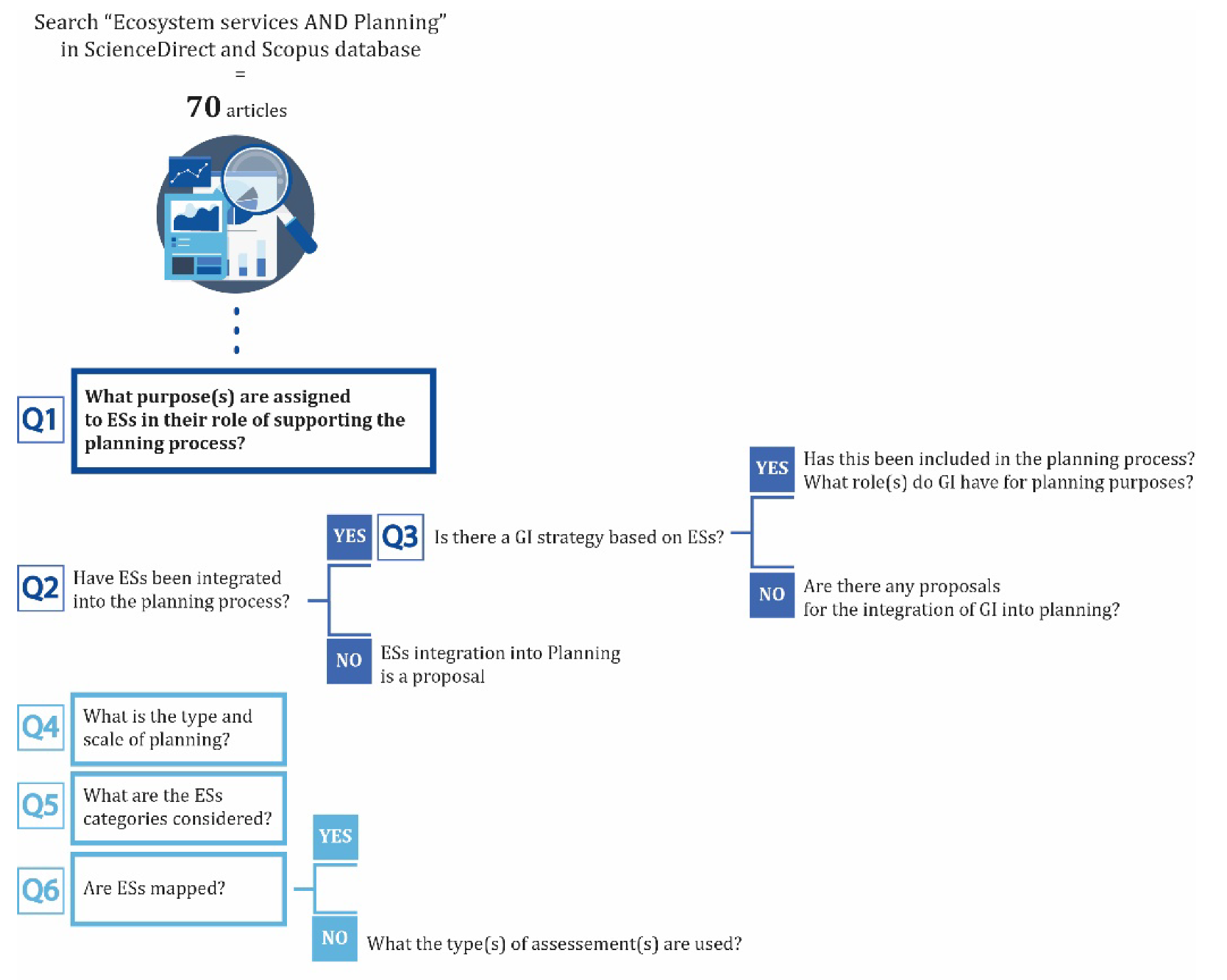
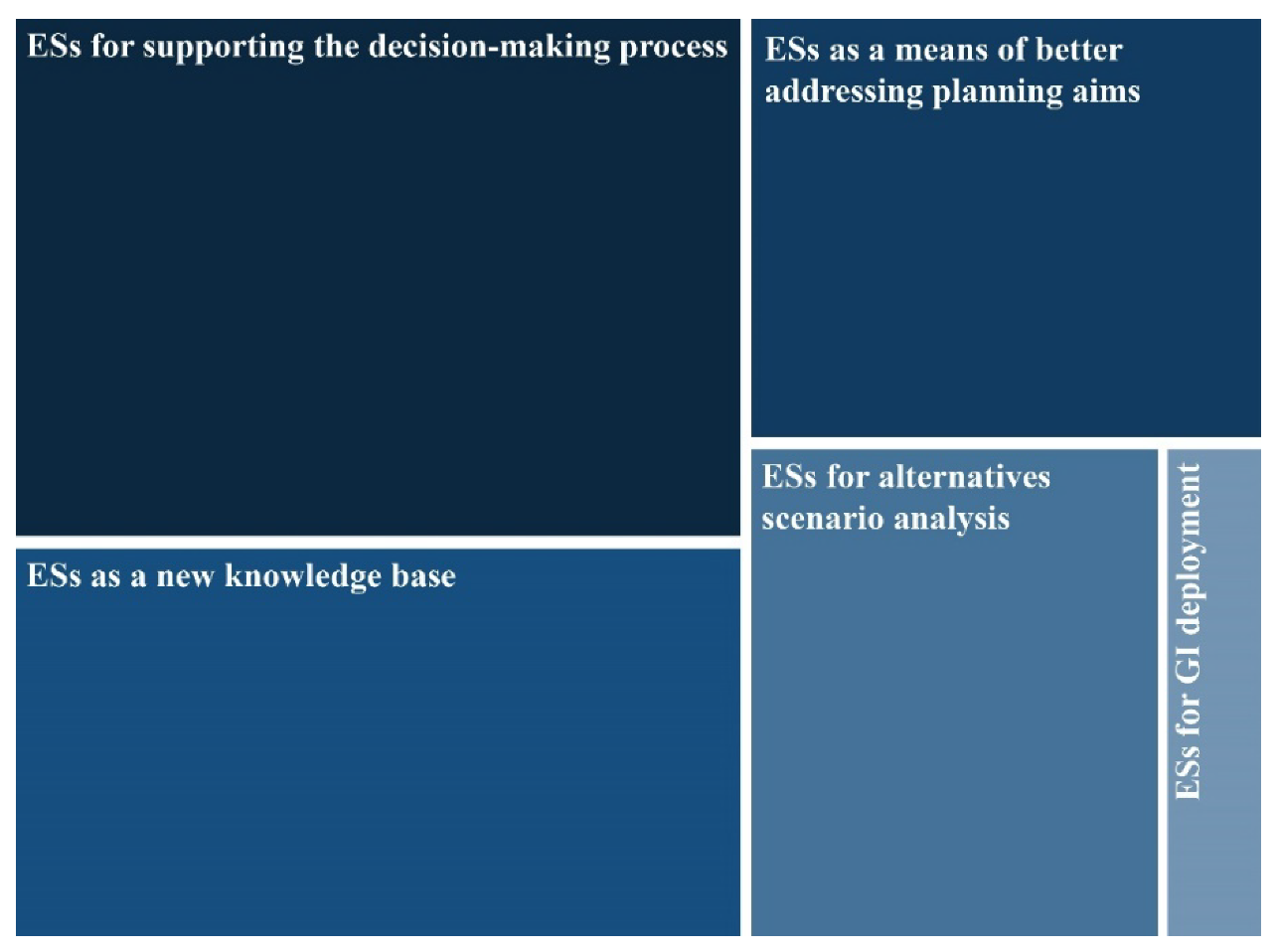
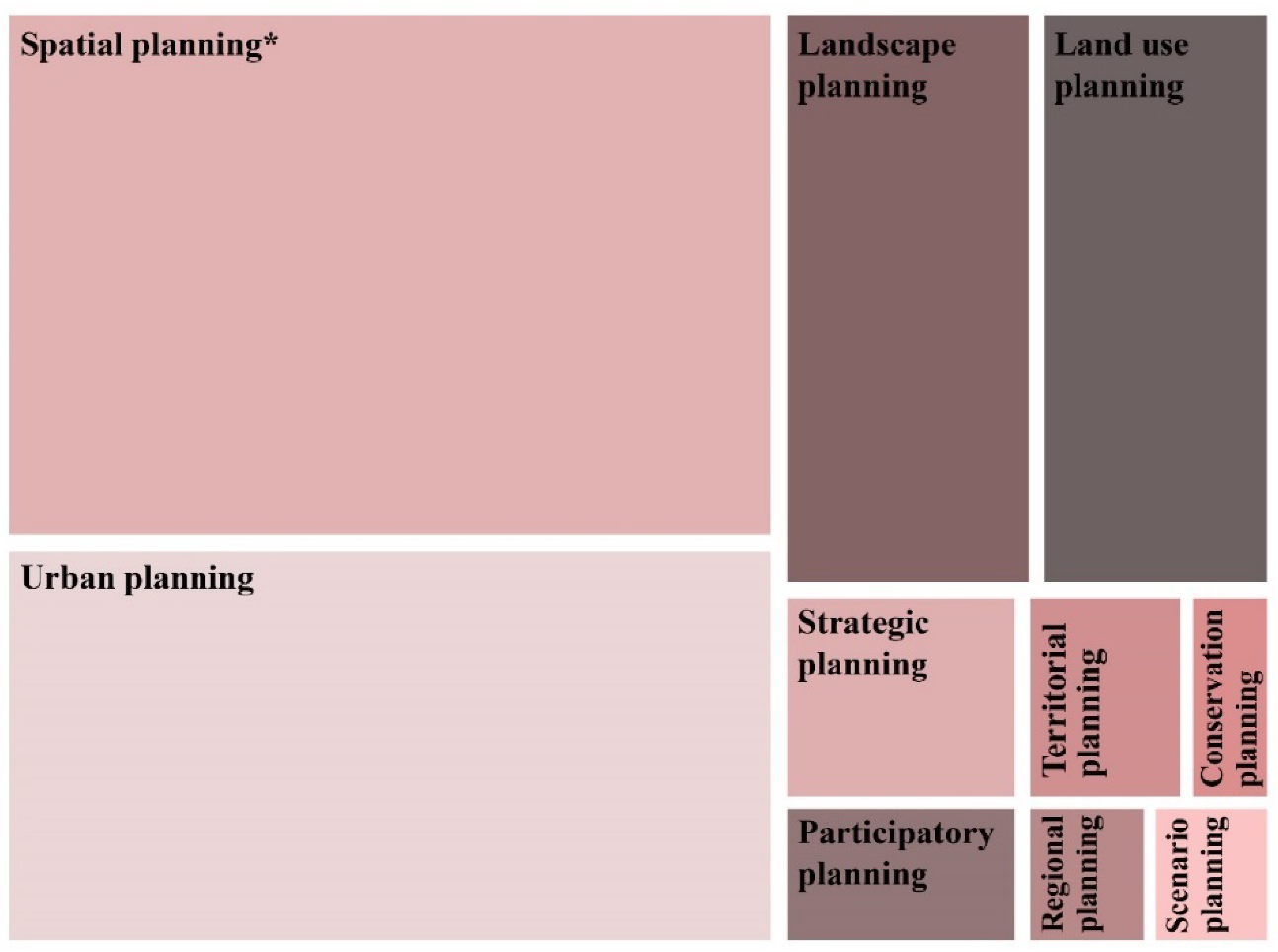
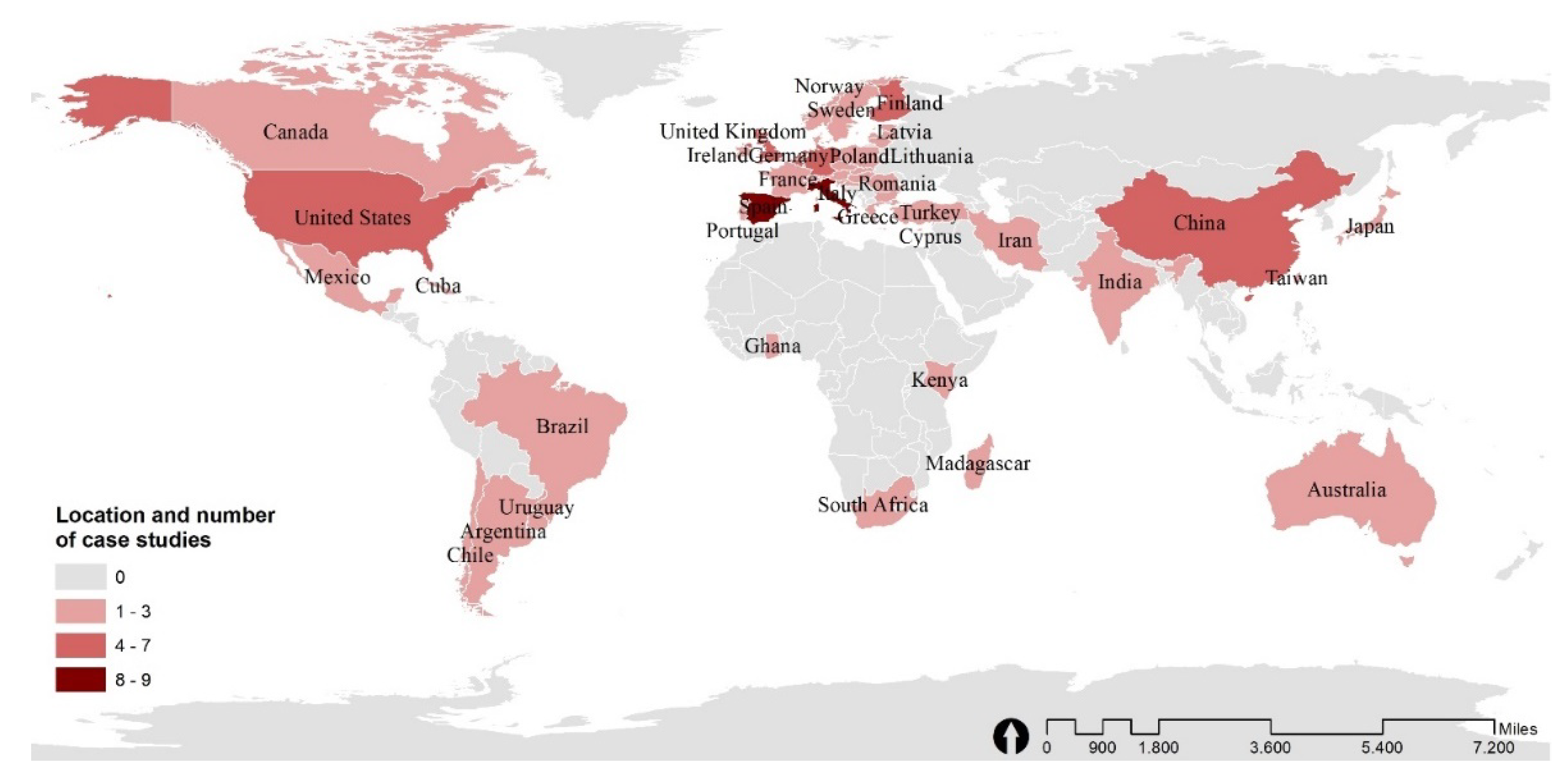
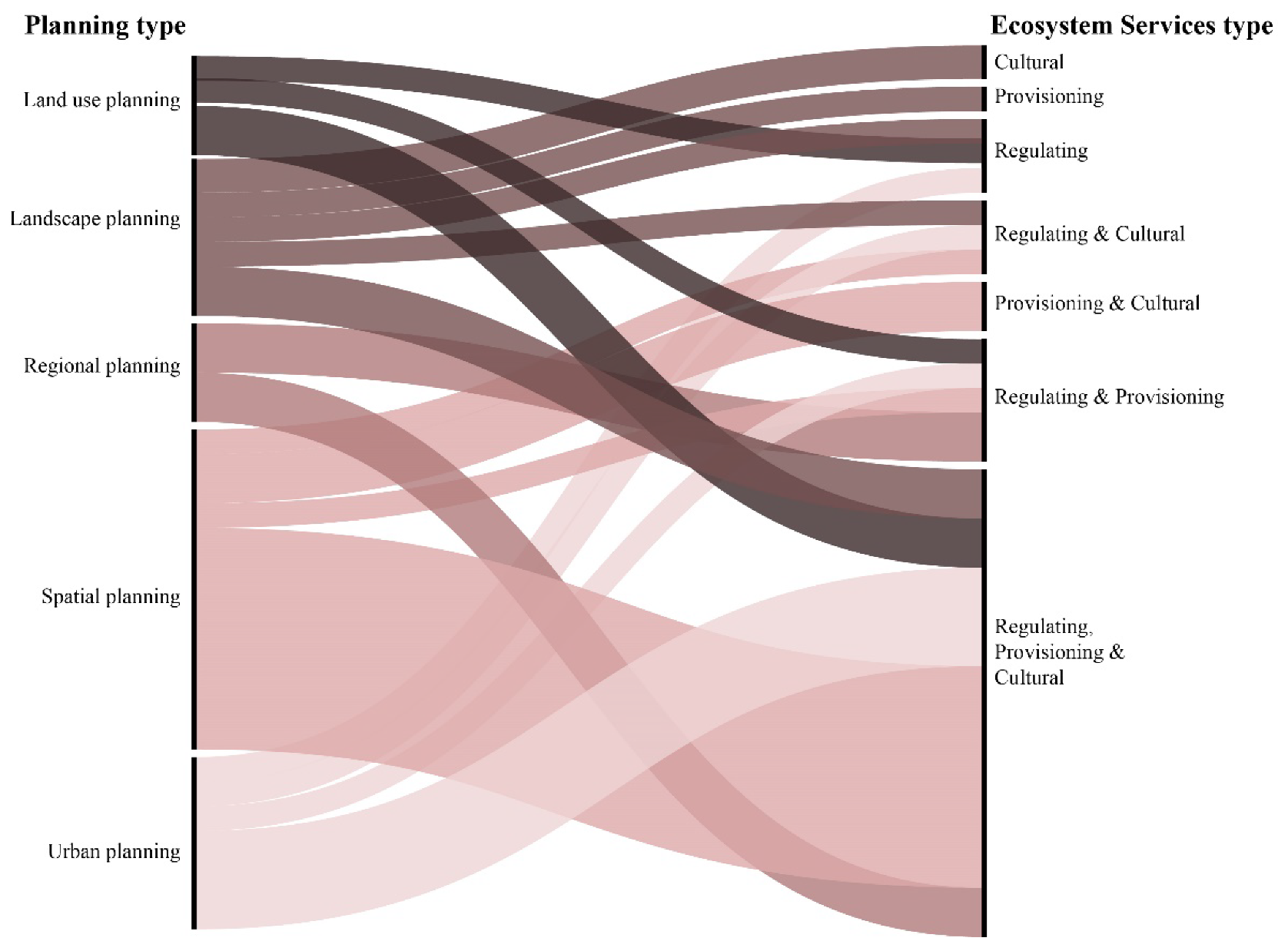
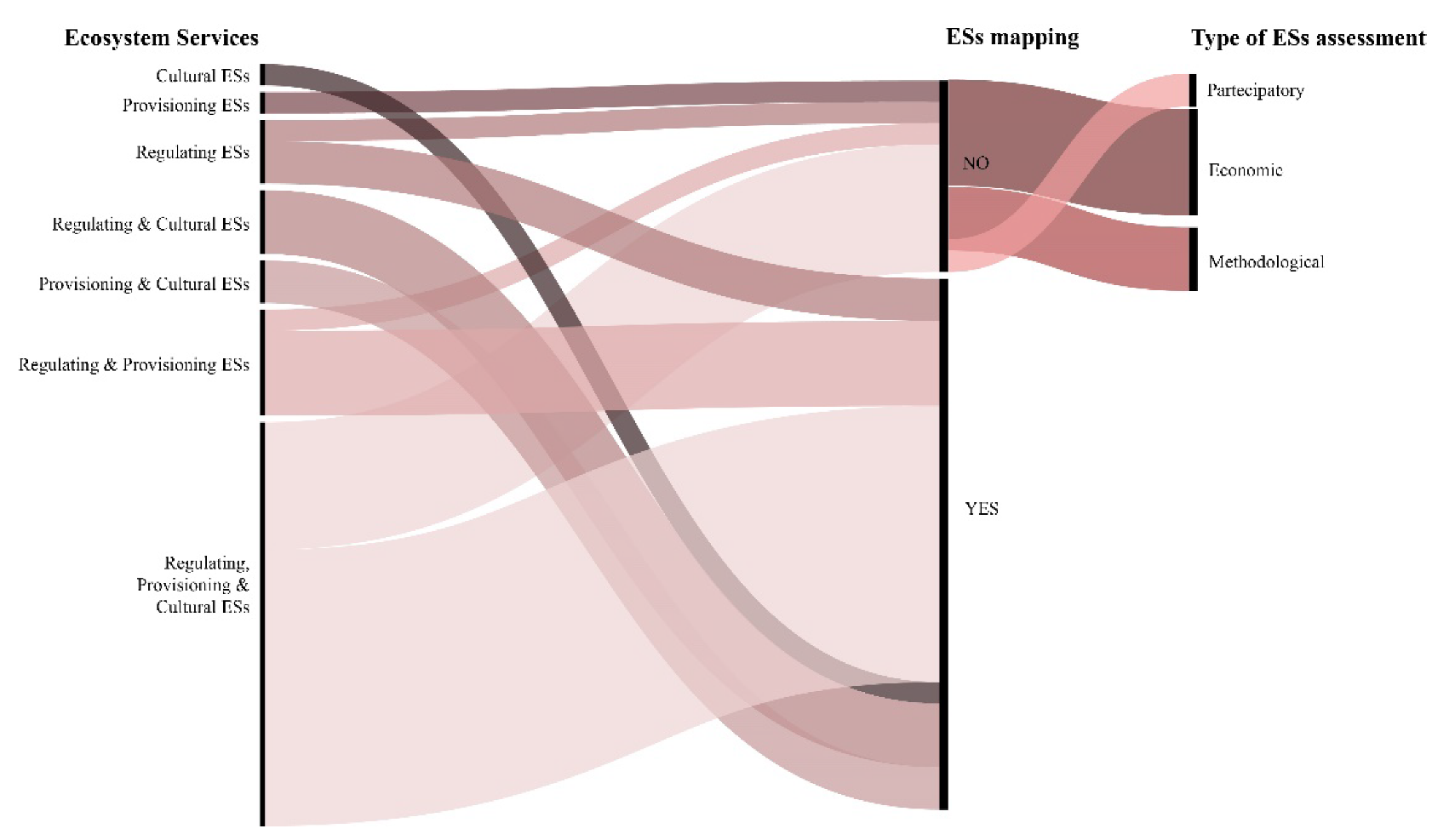
Publisher’s Note: MDPI stays neutral with regard to jurisdictional claims in published maps and institutional affiliations. |
© 2021 by the author. Licensee MDPI, Basel, Switzerland. This article is an open access article distributed under the terms and conditions of the Creative Commons Attribution (CC BY) license (https://creativecommons.org/licenses/by/4.0/).
Share and Cite
Ronchi, S. Ecosystem Services for Planning: A Generic Recommendation or a Real Framework? Insights from a Literature Review. Sustainability 2021, 13, 6595. https://doi.org/10.3390/su13126595
Ronchi S. Ecosystem Services for Planning: A Generic Recommendation or a Real Framework? Insights from a Literature Review. Sustainability. 2021; 13(12):6595. https://doi.org/10.3390/su13126595
Chicago/Turabian StyleRonchi, Silvia. 2021. "Ecosystem Services for Planning: A Generic Recommendation or a Real Framework? Insights from a Literature Review" Sustainability 13, no. 12: 6595. https://doi.org/10.3390/su13126595
APA StyleRonchi, S. (2021). Ecosystem Services for Planning: A Generic Recommendation or a Real Framework? Insights from a Literature Review. Sustainability, 13(12), 6595. https://doi.org/10.3390/su13126595





